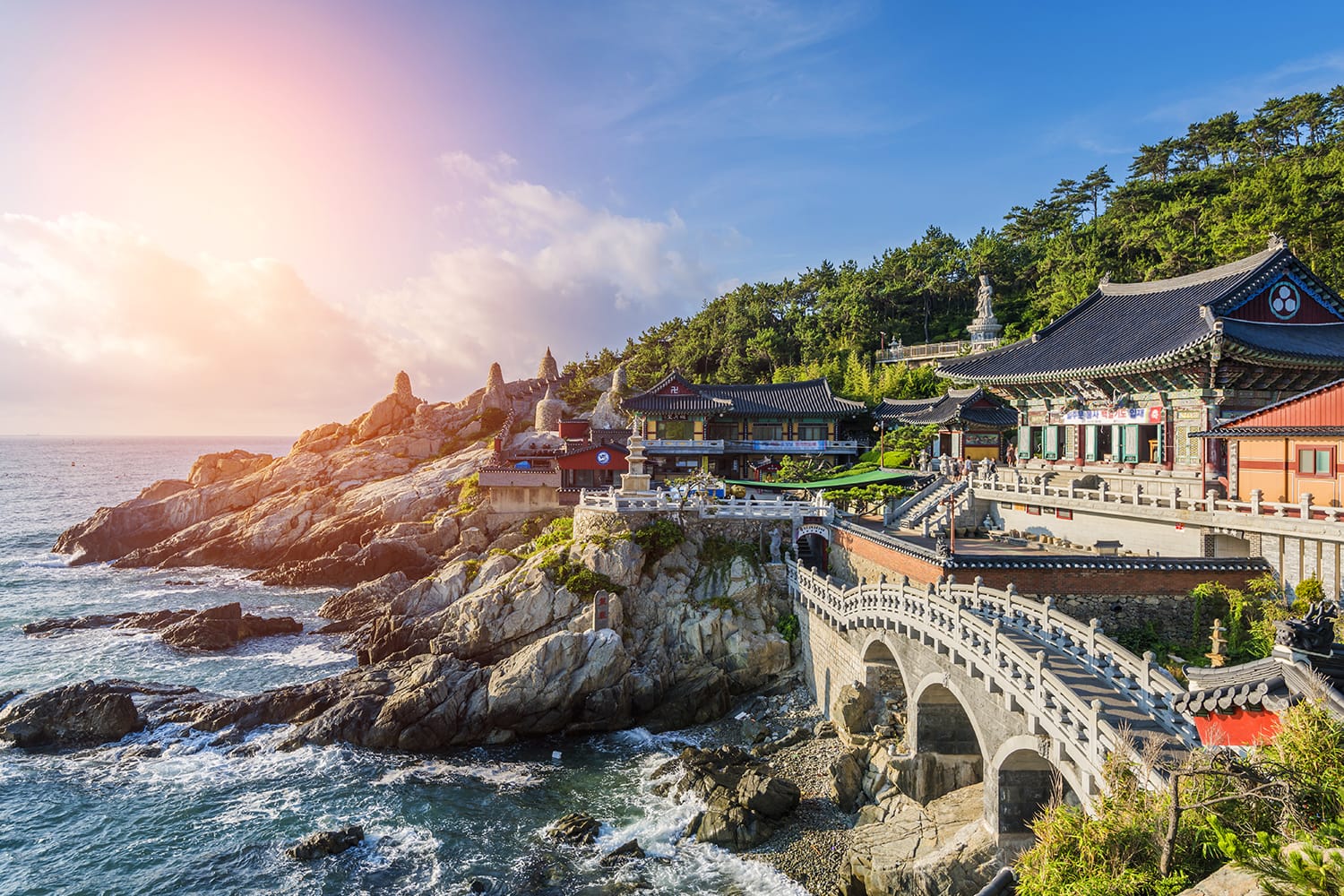
Busan, South Korea’s second-largest city, is a vibrant metropolis that seamlessly blends the energy of a bustling port with the tranquility of stunning coastlines. Unlike the more polished and fast-paced capital of Seoul, Busan offers a more relaxed and soulful experience, deeply rooted in its maritime heritage and a rich tapestry of cultural influences. From its iconic beaches and colorful villages to its ancient temples and bustling markets, Busan is a city that captivates the senses and leaves an indelible mark on every visitor.
This comprehensive guide will delve into the heart of Busan, exploring its top attractions, unraveling its fascinating history, providing practical travel tips, outlining accommodation options, navigating its efficient transportation system, and revealing the best times to embark on your own Busan adventure.
A Glimpse into Busan’s Storied Past

Related Articles about Busan Beckons: A Symphony of Sea, Culture, and Culinary Delights:
- Whispers of the Incas: Your Definitive Travel Guide to Machu Picchu
- Kenya: Where Wildlife Roams Free and History Whispers Through the Savannah
- Miami: A Kaleidoscope of Culture, Sun, and Unforgettable Experiences
- A Grand Tour of India: Unveiling the Best Hotels and Experiences
- Singapore: The Lion City’s Sparkling Embrace – A Comprehensive Travel Guide
Busan’s history is intrinsically linked to its strategic coastal location. For centuries, it served as a vital trading port, attracting merchants and travelers from across East Asia. Its significance grew exponentially during the Joseon Dynasty, where it played a crucial role in maritime trade and defense.
However, Busan’s modern identity was profoundly shaped by the Korean War (1950-1953). As the capital of South Korea shifted to temporary locations, Busan became a refuge for millions of displaced Koreans. The temporary shantytowns that sprung up during this period, like the now-famous Gamcheon Culture Village, are a poignant reminder of this tumultuous era and have since been transformed into vibrant artistic hubs. This resilience and ability to rebuild have become a defining characteristic of the city.
In recent decades, Busan has transformed into a global hub for commerce, culture, and tourism. It hosts the world’s fifth-largest container port and is renowned for its annual Busan International Film Festival (BIFF), which draws international attention and showcases the best of Asian cinema.
Unveiling Busan’s Crown Jewels: Top Attractions
Busan’s allure lies in its diverse range of attractions, catering to every kind of traveler. Here are some of the must-see sights:
1. Haeundae Beach: The Quintessential Busan Experience
No visit to Busan is complete without experiencing Haeundae Beach. This expansive sandy shoreline is the city’s most famous beach, a bustling hub of activity during the summer months. Lined with luxury hotels, trendy cafes, and seafood restaurants, it offers a perfect blend of relaxation and vibrant energy. During warmer months, you can swim in the clear waters, soak up the sun, or partake in water sports. Even in cooler seasons, the picturesque promenade is ideal for a leisurely stroll, with the iconic Dongbaek Island offering stunning views of the coastline.
2. Gamcheon Culture Village: A Kaleidoscope of Color and Creativity
Perched on a hillside overlooking the sea, Gamcheon Culture Village is a living testament to Busan’s resilience and artistic spirit. Once a humble shantytown formed during the Korean War, it has been transformed into a vibrant labyrinth of brightly painted houses, quirky art installations, and charming alleyways. Wandering through its narrow paths feels like stepping into an open-air museum. Don’t miss the iconic "Little Prince and the Fox" statue offering panoramic views, or the numerous art studios and cafes that dot the village.

3. Jagalchi Fish Market: A Feast for the Senses
Prepare for an olfactory and visual adventure at Jagalchi Fish Market, Korea’s largest seafood market. The air buzzes with the calls of vendors and the aroma of fresh catches. Here, you can witness an astonishing array of seafood, from live octopuses and crabs to a dazzling variety of fish. Many stalls offer the opportunity to select your own seafood and have it prepared on-site at one of the many attached restaurants. It’s an authentic and unforgettable culinary experience.
4. Beomeosa Temple: Serenity Amidst Nature
Escape the urban hustle and bustle at Beomeosa Temple, one of Korea’s oldest and most beautiful Buddhist temples. Nestled on the slopes of Geumjeongsan Mountain, it offers a serene sanctuary for reflection and spiritual exploration. The temple complex boasts impressive architecture, serene courtyards, and breathtaking natural surroundings. Hiking trails around the temple provide further opportunities to immerse yourself in the tranquil mountain landscape.
5. Gukje Market: A Shopper’s Paradise
For those who love to bargain and explore, Gukje Market is an absolute must. This sprawling traditional market is a treasure trove of goods, selling everything from clothing and accessories to household items and street food. It’s a place to get lost in the organized chaos, haggle for unique souvenirs, and sample delicious local snacks. Adjacent to Gukje Market, you’ll find BIFF Square, named after the Busan International Film Festival, which is a lively area with street food stalls and a chance to spot celebrity handprints.
6. Taejongdae Park: Dramatic Coastal Cliffs
Taejongdae Park is a natural wonderland characterized by its dramatic cliffs, dense forests, and stunning ocean vistas. Located on the southernmost tip of Yeongdo Island, it offers a dramatic contrast to the city’s urban landscape. Highlights include the iconic lighthouse, which offers panoramic views of the East Sea, and the observatory deck where you can gaze at the distant islands. A small train service, the Danubi train, makes it easy to explore the park’s various viewpoints.
7. Busan Museum of Art: A Cultural Hub
Art enthusiasts will find solace at the Busan Museum of Art. This impressive institution houses a diverse collection of both traditional Korean art and contemporary works. It regularly hosts temporary exhibitions featuring local and international artists, making it a dynamic and ever-evolving cultural destination.
8. Songdo Beach & Skywalk: A Modern Seaside Escape
Songdo Beach offers a more laid-back alternative to Haeundae, with a charming atmosphere and a unique attraction: the Songdo Skywalk. This cantilevered walkway extends over the water, offering spectacular views of the coastline and the vibrant marine life below. You can also take a cable car across the bay for even more breathtaking perspectives.
Navigating Busan: Travel Tips for a Smooth Journey
To make the most of your Busan adventure, keep these travel tips in mind:
- Language: While many tourist areas have English signage and some staff may speak basic English, it’s helpful to learn a few basic Korean phrases like "Annyeonghaseyo" (Hello) and "Kamsahamnida" (Thank you). Consider using a translation app.
- Currency: The currency in South Korea is the Korean Won (KRW). Credit cards are widely accepted in most establishments, but it’s advisable to carry some cash for smaller vendors and markets.
- Connectivity: Wi-Fi is readily available in hotels, cafes, and public spaces. Consider purchasing a local SIM card or pocket Wi-Fi device for constant connectivity.
- Etiquette: Koreans are generally polite and respectful. It’s customary to remove your shoes before entering someone’s home or certain traditional establishments. When dining, it’s polite to wait for elders to start eating.
- Power Outlets: South Korea uses Type C and F plugs with a voltage of 220V. Bring a universal adapter if necessary.
- Tipping: Tipping is not customary in South Korea and may even be considered impolite.
A Home Away From Home: Accommodation Options
Busan offers a wide spectrum of accommodation to suit every budget and preference:
- Luxury Hotels: For those seeking indulgence, Haeundae and the Centum City area boast world-class hotels with stunning ocean views, premium amenities, and exceptional service.
- Mid-Range Hotels: You’ll find numerous comfortable and well-equipped hotels throughout the city, particularly in areas like Seomyeon and Nampo-dong, offering a good balance of comfort and affordability.
- Boutique Hotels & Guesthouses: For a more personalized experience, consider charming boutique hotels or guesthouses, especially in areas like Gamcheon Culture Village or near the beaches, offering a unique local flavor.
- Hostels: Budget travelers will find a good selection of clean and friendly hostels, particularly in popular tourist areas, providing a social atmosphere and affordable lodging.
- Airbnb: Renting an apartment or room through Airbnb is a popular option for those seeking a more local living experience or for groups traveling together.
Getting Around Busan: Efficient and Accessible Transportation
Busan boasts an efficient and well-connected public transportation system, making it easy to explore the city:
- Subway: The Busan subway system is modern, clean, and extensive, connecting most major attractions and neighborhoods. It’s the most convenient and cost-effective way to travel. Purchase a T-money card for easy tap-and-go payment.
- Buses: Buses are an excellent option for reaching areas not directly served by the subway or for shorter distances. Routes can be complex, so using a navigation app or asking locals is recommended.
- Taxis: Taxis are readily available and relatively affordable, especially for shorter trips or when traveling in a group. They are a good option for late-night travel or when carrying luggage.
- KTX (Korea Train Express): If you’re arriving from other cities in South Korea, the KTX high-speed train offers a fast and comfortable journey to Busan Station.
- Ferries: For a scenic experience, consider taking a ferry to nearby islands or even to Japan from the Busan Port International Passenger Terminal.
The Sweet Spot: Best Time to Visit Busan
Busan experiences four distinct seasons, each offering a unique charm:
- Spring (March to May): This is arguably the best time to visit Busan. The weather is mild and pleasant, with blooming cherry blossoms creating a picturesque landscape. It’s ideal for outdoor activities and exploring the city without the intense summer heat.
- Summer (June to August): Summer is peak season, especially for beach lovers. The weather is warm and humid, perfect for swimming and enjoying water sports at Haeundae and other beaches. Be prepared for crowds and higher accommodation prices.
- Autumn (September to November): Another excellent time to visit, autumn offers crisp, clear weather and vibrant foliage. The temperatures are comfortable for sightseeing, and the city is less crowded than in summer.
- Winter (December to February): Winter in Busan is generally mild compared to inland areas, with average temperatures hovering around freezing. While not ideal for beach activities, it offers a quieter experience with opportunities to enjoy winter festivals and the festive atmosphere.
Busan: A City That Captivates
Busan is a city that defies expectations. It’s a place where the dynamism of a modern metropolis coexists harmoniously with the timeless beauty of its natural landscapes and the warmth of its people. Whether you’re seeking the thrill of bustling markets, the serenity of ancient temples, the vibrant artistry of its villages, or the simple pleasure of a day at the beach, Busan offers an unforgettable journey. So, pack your bags, embrace the adventure, and let Busan weave its magic on you.





